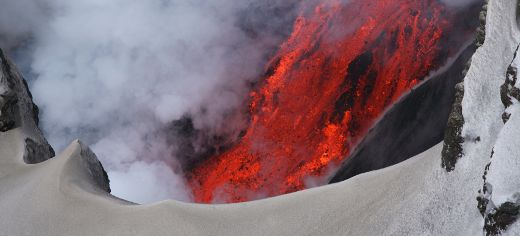
Predictions of where planes can safely fly following volcanic eruptions could be improved, thanks to fresh discoveries about ash clouds.
To study the size of ash grains and how far they can travel, scientists at the Met Office and the Universities of Leeds, Edinburgh and Iceland, compared grains recovered from recent Icelandic eruptions – including samples recovered in Yorkshire – with satellite measurements of ash clouds.
Their findings, published today in Atmospheric Measurement Techniques, will help to improve methods of mapping ash concentration in order to identify zones where it is safe to fly during future eruptions.
Hundreds of flights were cancelled in 2010 and 2011 following volcanic activity in Iceland because of the danger that volcanic ash posed to aircraft and their engines.
In the new study, researchers studied volcanic ash recovered in the UK from the recent Eyjafjallají¶kull and Grímsví¶tn eruptions, as well as prehistoric samples from peat bogs in Yorkshire, Scotland and Ireland. Another sample, from an 1875 eruption, had been in a museum for 140 years.
The researchers found that grains were much larger than what had been typically estimated by satellite measurements of ash clouds – even moderately-sized eruptions could disperse large grains as far as the UK.
Study co-author Dr Graeme Swindles, from the School of Geography at the University of Leeds, said: “Microscopic volcanic ash layers preserved in Yorkshire peat bogs and mud at the bottom of lakes, far from volcanoes, are providing much needed information on the characteristics of ash clouds. These records show us that Europe was hit by volcanic ash clouds very frequently in the past.”
The group also used computer models to simulate how clouds of various ash particle sizes would appear to satellite sensors. They found that sensors can underestimate the size of larger particles.
Dr John Stevenson, from the University of Edinburgh, who led the study, said: “Mapping volcanic ash clouds and their risk to aircraft is hard. Large regions of airspace can be contaminated by particles that are invisible to the naked eye. Combining the expertise of volcanologists and atmospheric scientists should help improve forecasts."
Further information
The study was supported by the Scottish Government and Marie Curie Actions via the Royal Society of Edinburgh.
The research paper, ‘Big grains go far: understanding the discrepancy between
tephrochronology and satellite infrared measurements of volcanic ash’, is published online in the journal Atmospheric Measurement Techniques on 19 May 2015.
Dr Graeme Swindles is available for interview. Please contact Sarah Reed, Press Officer at the University of Leeds, on 0113 34 34196 or email s.j.reed@leeds.ac.uk.